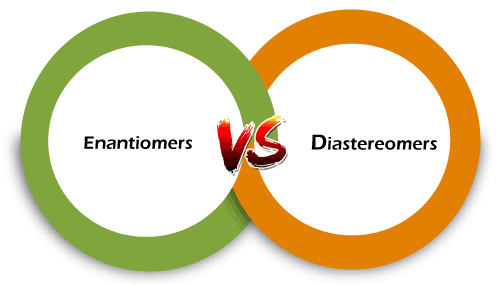Difference between Enantiomers and DiastereomersThere are several terms in chemistry that carry different meanings. Chemistry is a branch of science that deals with chemical reactions, chemical compounds, acids, bases, etc. All the gases, acids, etc., have a particular number associated with them. All these numbers are recorded in the periodic table. Now, every action has a reaction. Several acids and bases are mixed to give rise to a third compound that is used for several purposes. For instance, sulfuric acid is formed by mixing sulfuric trioxide with water or sulfur dioxide with oxygen. H2SO4 is industrially made through this contact process. So today, we will be discussing about molecular reactions and compounds, i.e., enantiomers and diastereomers. These two are a part of stereoisomers, i.e., the molecules have the same molecular formula and atoms, but they are distinguished in 3D orientations of atoms. Let us begin by understanding as to what enantiomers and diastereomers mean. 
EnantiomersEnantiomer is defined as the chemical compound wherein the mirror images are not superposable. They are a kind of stereoisomers, i.e., the mirror image of one another. Now, how to identify an enantiomer? Well, an enantiomer can be identified by a distinguished direction, i.e., the direction in which they give out the polarized light. The light can either be dextro or levo rotation. Enantiomers are optical isomers. When the two enantiomers are in equal proportions to one another, it is called a racemic mixture. Now, many of us confuse enantiomers with chiral. However, they are different. Enantiomers are molecules existing in two forms that are not superposed on each other, unlike chiral. The base of the structure of the enantiomer is called chiralism. Chiral and enantiomers are different from one another. So, now let us discuss the structure of enantiomers.
DiastereomersDiastereomers are defined as the chemical compounds wherein there are non-mirror images. The diastereomers are another form of stereoisomers, having a ring structure. Diastereomers do not have any mirror images. In other words, diastereomers are chemical compounds having the same molecular formula. The elements are non-super-imposable and the images formed are non-mirror. Examples of diastereomers include double bond isomers, cis-trans isomers, and stereoisomers with several chiral centers. Diastereomers are not necessarily optically active, and that is why they differ from enantiomers. Some of the characteristics of diastereomers are that they have a different melting point, a different boiling point, the solubility is varied, and the chemical properties are different. Now, enantiomers and diastereomers are different in several aspects. So, let us look at the significant contrasting points between them.
So, these are some of the significant contrasting points between enantiomers and diastereomers. They differ majorly in molecular form and configuration. Now, there are several properties associated with enantiomers and diastereomers. So, let us take a look at them. Characteristics of Enantiomers
Characteristics of Diastereomers
So, these are some of the properties regarding enantiomers and diastereomers. They both are a form of stereoisomers that have the same molecular interaction but different orientations of atoms. They differ in several aspects like configuration, molecular shapes, compound formation, etc. The major contrasting point between them is that of the images formed, i.e., enantiomers form mirror images, while diastereomers form non-mirror images. Thus, both enantiomers and diastereomers are essential aspects of chemistry that focus on molecular reactions in order to form a compound.
Next TopicDifference between
|
 For Videos Join Our Youtube Channel: Join Now
For Videos Join Our Youtube Channel: Join Now
Feedback
- Send your Feedback to [email protected]
Help Others, Please Share










